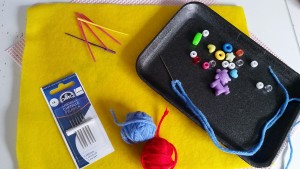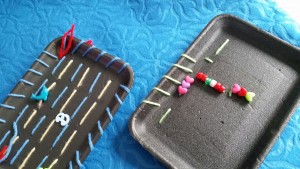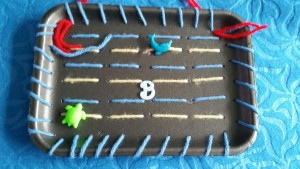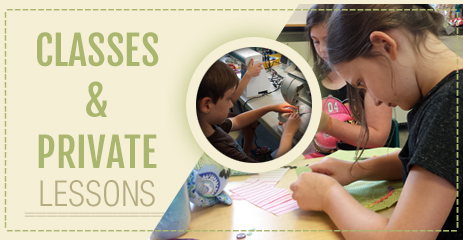Teaching your Young Child to Hand Sew

You will need:
Needle with a large eye (I use a Chenille Size 18 which can be gripped by little fingers)
Yarn or floss (use all 6 strands together)
Felt
Plastic canvas
Heavier paper such as poster board
Paper plates with holes punched around the edges, or a styrofoam plate used for food (I get Persian Cucumbers from Trader Joe’s)
Scotch tape to secure the yarn if you are using paper plates or styrofoam
Scissors Paper Punch if using a paper plate or paper
Optional: Pony beads or other large beads for the needle
Begin the sewing lesson by showing your young sewer the needle that you will use for stitching. Be sure to show them the point of the needle and tell them that it is sharp so it can pierce the fabric. If they want, let them feel the point although most are curious and will do this on their own! Show them the eye of the needle and tell them that this is where the thread is added so we can stitch. Thread the needle while they are watching and show them how the thread is knotted. If your child is interested in trying to thread the needle and make the knot let them try. Otherwise, show them how it’s done and wait until your child has stitched for awhile. If you are using poster board or a paper plate, take your hole punch and make holes around the outside rim of the plate or shape. Before you begin to stitch show them how to hold the yarn or floss at the base of the eye while stitching so that the yarn does not pull out after each stitch.
Running stitch:
My students, young and old, begin their stitching journey with learning the running stitch. This basic stitch is made by bringing the needle up from the back or underside of the fabric, moving over about a quarter to half an inch and sending the needle back down to the underside of the fabric. The stitches can be all even or can vary in length depending on what your child is using to practice stitching (styrofoam, felt etc.) Show your child how to hold the eye of the needle and the thread each time they begin to stitch. Keeping the yarn or the floss in the eye of the needle is by far the hardest part of the lesson. Have your child bring the needle from the underside or back of the fabric. Pull the yarn or floss all the way up to the front. Now, reinsert the needle back down into the fabric to the underside and pull all the thread through again. One stitch completed! Make rows of running stitches like railroad tracks back and forth until you have filled your empty space or stitched around the edges of your paper plate. At the end of each row either knot the yarn or cut and tape the yarn to the backside of your work. Change colors for each line of stitching or try making big or little stitches. Let your child be creative! Optional: When your sewer brings the needle to the right side of the felt, plate, or needlepoint canvas, have them add a pony bead or beads before they insert the needle back down into the fabric to the underside. Have fun and let them be free to be creative!

Overcast or Whip Stitch:
Once your sewer has somewhat mastered the running stitch let them move on to the overcast or whip stitch. Have them bring the needle up through the underside about a quarter to a half inch in from the edge of the plate or fabric. Now, instead of going back down to the underside from the front, take the needle over the edge and go back to the underside and bring the needle back up through the fabric or other medium to the front about a quarter to a half inch from the first stitch. Remember your stitches will be going over the edge each time instead of being stitched in an up and down motion. Be patient as your sewer tries to master these two basic stitches. Often my students will start with a running stitch and end up stitching several overcast stitches. It’s at this point where I remind them that they are new to sewing and it will take time to master a new skill. I take the misguided stitches out and encourage them to continue reminding them that sewing is a “learned skill” and “practice makes perfect!”

Have fun stitching with your children.
Until next time……
Ms. Bobbi

 Laces & Trims
Laces & Trims Patterns
Patterns
 Books & Magazines
Books & Magazines Dolls
Dolls Galleria
Galleria
